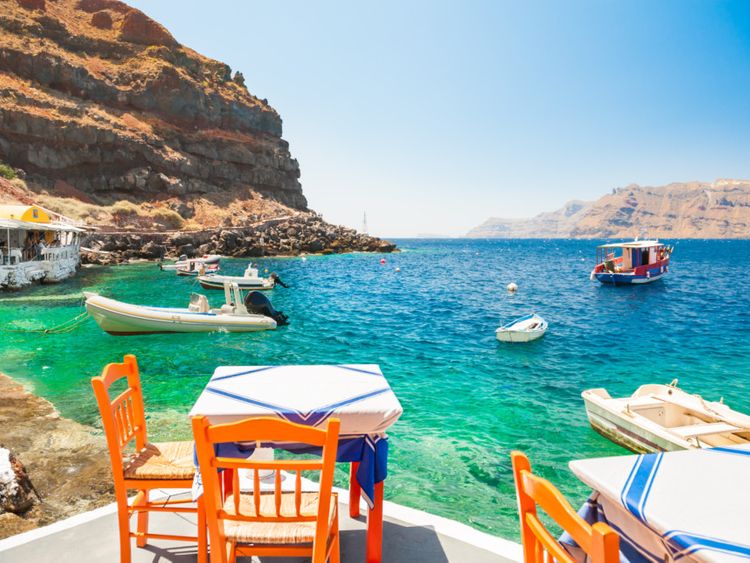SANTORINI, Greece - The bride wore a sparkling tiara and a flowing red wedding gown, her fifth matrimonial ensemble of the day. The groom wore a silver tuxedo and the fatigued look of a guy who had spent the past dozen hours posing for pictures.
The photographer gave instructions. Reenact the proposal on bended knee. Twirl in the dress. Kiss the bride’s hand.
But it was nearly sunset, and the couple still hadn’t captured that perfect Santorini picture to display at their traditional wedding in China next month.
So their photographer, who is based in Shanghai, rushed the pair across the island’s whitewashed roofs and narrow cliffside footpaths, coaching them in Chinese at various scenic outlooks.
Above a luxury hotel renowned in China as the setting for a popular romantic comedy, he told the weary groom to lift his betrothed in an over-the-threshold pose. The third try was the charm.
For a grand finale, the couple stared into each other’s eyes on a rooftop, and the photographer framed their silhouettes around the blood-orange sun, sinking behind them into the shimmering Aegean Sea. It was the stuff pre-wedding-picture dreams were made of.
“Santorini is famous in China,” said the 29-year-old groom, Yao Kai, after the final click of the camera.
Unlike his parents, who he said had sat stoically for their wedding photos in China, the groom had the good fortune to have seen the world - and wanted his friends, family and wedding guests to see him seeing it.
“This is a great moment for our country’s economy,” he added. “We are getting stronger.”
SANTORINI’S UNBEARABLY BEAUTIFUL AND THAT’S THE PROBLEM
Pre-wedding pictures have become a multibillion-dollar business in the Instagram age - particularly for Asian couples.
Many Chinese brides and grooms who plan for traditional ceremonies back home go first for professional photographs under the Eiffel Tower in Paris, at Big Ben in London and in the English countryside. (“A Downton Abbey effect on Chinese pre-wedding photo shoots,” the South China Morning Post reported.) New Zealand and Antarctica are the latest pre-wedding destination hot spots.
But the deep blues and white-out whites of Santorini exercise a particular hold on the romantic imagination of many an Asian nearlywed.
“A lot of people come,” said Xu Kaiyue, the photographer’s assistant. “Too many people.”
Santorini is fatally picturesque. Armadas of cruise ships and low-cost air carriers carry selfie and Instagram addicts to its clogged towns. Airbnbs have replaced residents. The island’s donkeys buckle under the burden of portly visitors.
To profit off the Chinese market, Greek photographers have developed websites with galleries of stunning brides-to-be stretching languorously or leading white horses on the beach.
The island’s officials, like their counterparts across Greece, have pursued Chinese investment during the country’s economic crisis, and appreciate the lucrative surge in Chinese visitors.
Luke Bellonias, an island official, said the Chinese had extended the tourist season deep into autumn when most Europeans and Americans have gone home. “They just love to take photos,” he said. “They don’t love the sun that much.”
Still, he acknowledged, “This gets a bit out of control.”
JUST FOR A FEW TENS OF THOUSAND DOLLARS
Foreign photographers, complete with makeup crews, large stocks of wedding dresses and stylists, live for months on the island but dodge taxes, he said. The financial police rarely enforce the law, giving free rein, he said, to people “holding wedding dresses above their heads and two or three bags and running from place to place.”
For many couples, fees running into the tens of thousands of euros are a small price to pay for an image that they say encapsulates both true romance and social mobility.
“It’s as important, if not more important, than the ring,” said Olivia Martin-McGuire, director of “China Love,” a documentary about the industry.
And for couples unable to afford the real thing, there are photo studios in Shanghai with Santorini sets.
“It’s very meaningful,” Martin-McGuire said.
THE COUPLE FROM TAIWAN
Having pre-wedding pictures shot on Santorini itself seemed to mean the world to 26-year-old Tzuchi Lin, and his fiancee, Yingting Huang, from Taiwan.
“It’s very exciting. Actually, we didn’t sleep last night,” Lin, who is known as Kenny, said in his hotel room early one recent morning. His 30-year-old fiancee, who uses the name Penny, applied hair spray in front of two wedding gowns draped from the window shutters.
“Now she can show off to her friends: ‘I went to Santorini to have my pre-wedding photos,’ “ he said.
The couple, from Taiwan, where some pre-wedding scholars say the industry began, slipped into something less comfortable. Lin wore a tuxedo with a maroon bow tie, and Huang an empire-waist white gown with lace bodice. She folded a second dress into a paper bag.
“We got them from Taobao,” Lin said. “China’s Amazon.”
In the parking lot, they met their photographers, Toto Kuo, a Taiwan native, and her husband of three months, Georgios Galanopoulos.
The two photographers led their clients to Oia, the town on the photo-bombarded tip of the island, where they set up shop in Galanopoulos’ family art gallery.
After a wardrobe change, the couple got their blue dome backdrop and nailed a rooftop proposal shot.
“Will you marry me?” Lin said in English.
“Say yes,” coached Kuo.
“Yes,” the bride said.
A crowd gathered below applauded warmly.
The New York Times News Service














